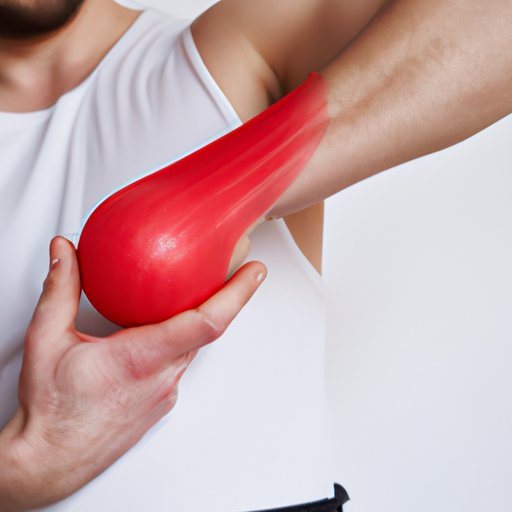
I. Introduction
Pulled muscles are a common injury that can happen to anyone, no matter their age or level of activity. However, they can range in severity and cause varying levels of pain and discomfort. It’s essential to know how to identify and manage a pulled muscle effectively to prevent further damage and speed up recovery. In this article, we will explore the symptoms of a pulled muscle, differentiate it from other common injuries, discuss when to seek medical help, and provide tips on how to treat and prevent future strains.
II. Symptoms of a Pulled Muscle: How to Identify if You’re Dealing with a Strain
If you’ve ever suffered from a pulled muscle, you know how painful and uncomfortable it can be. A pulled muscle often feels like a sharp or dull ache in the affected area. Common areas where pulled muscles occur include the neck, back, shoulders, and thighs.
Symptoms of a pulled muscle include:
- Sudden or intense pain
- Swelling
- Tenderness to the touch
- Bruising
- Weakness or stiffness
- Muscle spasms
III. The Difference between a Pulled Muscle and Other Common Injuries
It’s essential to differentiate between a pulled muscle and other severe injuries before proceeding with treatment. Common injuries that may be mistaken for a pulled muscle include:
- Torn ligament
- Torn muscle
- Bone fracture
- Nerve injury
It’s crucial to know the signs and symptoms of each injury to prevent further damage and receive appropriate treatment.
IV. When to See a Doctor for a Pulled Muscle: A Guide to Seeking Medical Help
It’s essential to seek medical help if the pain is severe, and movement is limited or if you’re unable to put weight on the affected area.
Medical professionals may recommend various treatments based on the severity of the injury, such as:
- Anti-inflammatory medication
- Icing the affected area
- Physiotherapy and massage
- Corticosteroid injections
- Surgery (in severe cases)
V. First Aid for a Pulled Muscle: What You Should (and Shouldn’t) Do
After injuring yourself with a pulled muscle, it’s essential to treat the affected area with caution. Here are a few dos and don’ts to keep in mind:
Do:
- Rest the affected area
- Elevate the injured area to reduce swelling
- Apply ice to the area for 20 minutes every few hours
- Compress the area with a wrap or bandage
- Use over-the-counter anti-inflammatory medication to reduce pain and swelling
Don’t:
- Apply heat to the affected area, which can increase swelling
- Massage the injured area too vigorously, which can aggravate the injury
- Return to physical activity too soon, which can cause further damage and delay healing time
VI. How to Speed Up Recovery from a Pulled Muscle: Tips and Techniques
Many self-care techniques can help speed up recovery from a pulled muscle. To help promote healing and reduce pain and discomfort, consider trying these tips:
- Rest the affected area as much as possible
- Perform gentle exercises and stretches to promote healing
- Use a foam roller or massage ball to reduce muscle tension and promote circulation
- Eat a healthy diet filled with anti-inflammatory foods
- Stay hydrated to help flush out toxins and promote healing
- Get plenty of sleep to optimize recovery time
If your symptoms are severe, you should consider seeking the help of a medical professional. They may recommend further treatments like physiotherapy and corticosteroid injections to promote healing.
VII. Preventing Future Muscle Strains: Exercises and Lifestyle Changes That Can Help
While it’s impossible to prevent all muscle strains, there are ways to reduce the risk of them happening. Here are a few tips on how to help prevent future muscle strains:
- Warm-up before engaging in physical activity
- Use proper form and technique during physical activity
- Incorporate strength training to strengthen weak muscles
- Stretch regularly to improve flexibility and range of motion
- Stay hydrated and eat a healthy, balanced diet to help optimize muscle function
VIII. The Anatomy of a Pulled Muscle: Understanding How and Why Strains Occur
A pulled muscle occurs when you overwork or overstretch the muscle causing it to become strained. Strains happen when the muscle fibers are torn or ruptured, causing pain and discomfort. Taking the necessary precautions like warming up and stretching before physical activity can help reduce the risk of a pulled muscle. Incorporating strength training and regular stretching into your fitness routine can also help prevent future muscle strains.
IX. Conclusion
While a pulled muscle is a common injury, it’s essential to know how to identify it and seek the proper medical treatment if necessary. To recover from a pulled muscle, it’s essential to take it easy, use some self-care techniques like stretching, apply ice to the affected area, and more. Most importantly, take measures to prevent future muscle strains by warm up before exercise, using the right form and technique during physical activity, and incorporating exercises that help prevent future muscle strains. By doing so, you can reduce the risk of a pulled muscle and stay injury-free.




